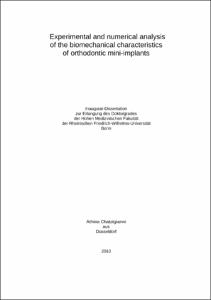Chatzigianni, Athina: Experimental and numerical analysis of the biomechanical characteristics of orthodontic mini-implants. - Bonn, 2010. - Dissertation, Rheinische Friedrich-Wilhelms-Universität Bonn.
Online-Ausgabe in bonndoc: https://nbn-resolving.org/urn:nbn:de:hbz:5N-21407
Online-Ausgabe in bonndoc: https://nbn-resolving.org/urn:nbn:de:hbz:5N-21407
@phdthesis{handle:20.500.11811/4323,
urn: https://nbn-resolving.org/urn:nbn:de:hbz:5N-21407,
author = {{Athina Chatzigianni}},
title = {Experimental and numerical analysis of the biomechanical characteristics of orthodontic mini-implants},
school = {Rheinische Friedrich-Wilhelms-Universität Bonn},
year = 2010,
month = jul,
note = {Objective: Mini-implants are being utilised as anchorage units in orthodontic treatment. Nevertheless, there seem to be influencing factors that interfere with their clinical performance. The aim of this study was to experimentally and theoretically examine four different parameters, which may have an influence on the primary stability of orthodontic mini-implants. These were 1) implant type, 2) implant length, 3) implant diameter and 4) insertion angle.
Material and Methods: A total of 90 mini-implants were inserted in fresh segments of bovine ribs. Implants were of two types, the Aarhus and the LOMAS mini-implant, of two lengths (7 mm and 9 mm) and of two diameters (1.5 mm and 2 mm, LOMAS only). A closed NiTi coil-spring was attached to each mini-screw. Half of the preparations were loaded with a low force of 0.5 N, the other half with a high force of 2.5 N. Mini-implant deflections during force application were non-invasively registered using a 3D laser-optical system. A subsequent finite element analysis of the applied force systems and the resulting mini-screw deflections was performed.
Results: In the small force group, implant displacements showed no statistically significant difference according to the investigated parameters. In the high force group the 9mm mini-implants displaced significantly less (mean 11±8 μm) than the 7 mm long (mean 22±11 μm, p<0.01), and the 2 mm wide significantly less (mean 9±2 μm) than the 1.5 mm ones (mean 22±2 μm, p<0.001). The force level where significance occurs was found to be 1 N. LOMAS mini-implants rotated significantly more than the Aarhus mini-implants at all force levels. Intra-observer agreement showed good correlation between experimental and numerical findings.
Conclusion: Implant length and implant diameter become statistically significant influencing parameters on implant stability only when a high force level is applied. Numerical results showed a good correlation to the experimental ones.},
url = {https://hdl.handle.net/20.500.11811/4323}
}
urn: https://nbn-resolving.org/urn:nbn:de:hbz:5N-21407,
author = {{Athina Chatzigianni}},
title = {Experimental and numerical analysis of the biomechanical characteristics of orthodontic mini-implants},
school = {Rheinische Friedrich-Wilhelms-Universität Bonn},
year = 2010,
month = jul,
note = {Objective: Mini-implants are being utilised as anchorage units in orthodontic treatment. Nevertheless, there seem to be influencing factors that interfere with their clinical performance. The aim of this study was to experimentally and theoretically examine four different parameters, which may have an influence on the primary stability of orthodontic mini-implants. These were 1) implant type, 2) implant length, 3) implant diameter and 4) insertion angle.
Material and Methods: A total of 90 mini-implants were inserted in fresh segments of bovine ribs. Implants were of two types, the Aarhus and the LOMAS mini-implant, of two lengths (7 mm and 9 mm) and of two diameters (1.5 mm and 2 mm, LOMAS only). A closed NiTi coil-spring was attached to each mini-screw. Half of the preparations were loaded with a low force of 0.5 N, the other half with a high force of 2.5 N. Mini-implant deflections during force application were non-invasively registered using a 3D laser-optical system. A subsequent finite element analysis of the applied force systems and the resulting mini-screw deflections was performed.
Results: In the small force group, implant displacements showed no statistically significant difference according to the investigated parameters. In the high force group the 9mm mini-implants displaced significantly less (mean 11±8 μm) than the 7 mm long (mean 22±11 μm, p<0.01), and the 2 mm wide significantly less (mean 9±2 μm) than the 1.5 mm ones (mean 22±2 μm, p<0.001). The force level where significance occurs was found to be 1 N. LOMAS mini-implants rotated significantly more than the Aarhus mini-implants at all force levels. Intra-observer agreement showed good correlation between experimental and numerical findings.
Conclusion: Implant length and implant diameter become statistically significant influencing parameters on implant stability only when a high force level is applied. Numerical results showed a good correlation to the experimental ones.},
url = {https://hdl.handle.net/20.500.11811/4323}
}






